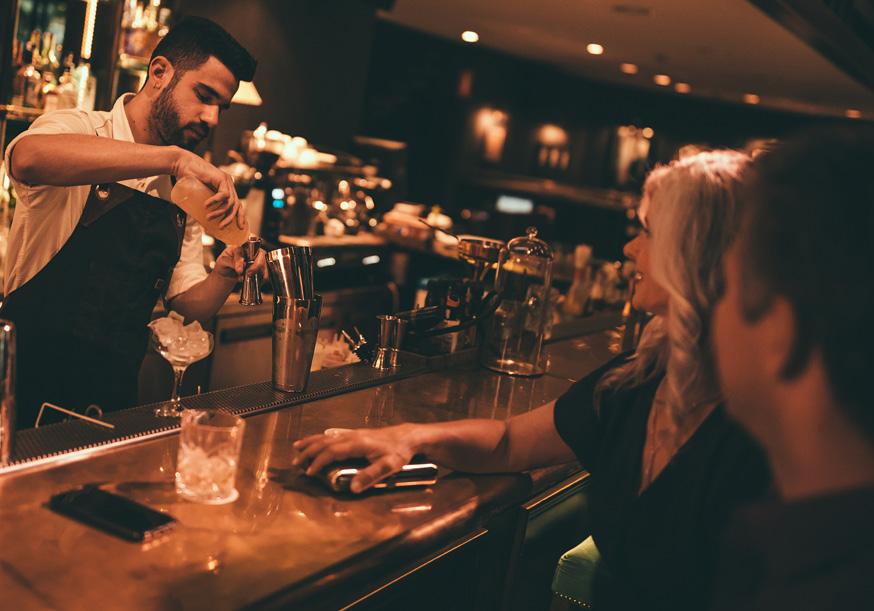Sexual harassment and bullying are rife within the legal community, but a new report, outlining steps for transforming the way lawyers work, is cause for optimism.
“Suck my d***”
These are not the kind of words you would expect from a lawyer at a conference dinner. However, these words, addressed by a male barrister to a female clerk, are now preserved in case law following Council of the New South Wales Bar Association v EFA (a pseudonym) [2021].
It’s one of many examples of inappropriate behaviour that have come to light since the International Bar Association (IBA) released its landmark Us Too? report in 2019. This reported on a survey of almost 7,000 respondents in 135 countries confirming that sexual harassment and bullying are rife in the legal profession. The IBA has released a follow-up recently, Beyond Us Too?, looking at the actions being taken to stamp them out.
‘Vulgar and inappropriate’
EFA had consumed a “considerable quantity of alcohol” before approaching his friend and greeting him in a way that in part parodied oral sex. Then he moved towards a legal professional, making his obscene remark. Though he denied the allegations, the event was recorded in its entirety on CCTV cameras from two different angles. There was no audio, but NCAT and the Court of Appeal were both satisfied that it was verbalised, given the woman’s visible and immediate distress.
NCAT found the behaviour to be “poorly judged, vulgar, and inappropriate”. The Court of Appeal, led by Chief Justice Bathurst, said the words “elevated the respondent’s conduct into a dimension warranting severe condemnation”. The Court upheld NCAT’s decision that this was unsatisfactory professional conduct.
It was not deemed professional misconduct, though, because it didn’t have a “real and substantial connection with professional practice” and because it didn’t indicate he had a character flaw that would render him unfit to practice. Both jurisdictions weighed up multiple disciplinary options, including a fine and mandatory counselling. In the end, EFA was formally reprimanded and it was ordered that his identity in the case be suppressed for 20 years.
Though the case was an administrative matter, it garnered considerable media attention as the public wrestled with the decision. “Why was [this] conduct deemed merely ‘unsatisfactory’?” queried legal academic Simon Rice in The Guardian. “What does that say about lawyers’ professional standards?”
Under the office carpet
Sexual harassment isn’t new. The American Bar Association, for example, established the Commission on Women in the Profession back in 1987, chaired by Hillary Rodham Clinton. It reported the following year that sexual harassment was a “serious obstacle” to women’s advancement on the legal ladder.
However, public attention goes in cycles. The new report highlights waves of commissions and reports that have flowed in and out of the profession’s consciousness during the 1980s, 1990s, and 2000s. The most recent period of navel gazing came shortly after the #MeToo movement of 2017, when allegations of sexual harassment were made against Hollywood heavyweight Harvey Weinstein, sparking outrage and prompting many industries to address behavioural issues long swept under the office carpet.
The Beyond Us Too? report relies on a global survey of about 70 organisations with legal regulatory and disciplinary powers. Author Kieran Pender, a member of the Law Society’s Diversity and Inclusion Committee, found some progress has been made. Most respondents agree sexual harassment issues are a priority. Most have reporting channels. Half of them had taken disciplinary action in relation to sexual harassment. More than a third offered relevant training, while a quarter had dedicated staff working on these issues. About the same had taken active steps to gather specific data.
These are positive developments, but there are two glaring problems. First, why is this happening? And second, why are these incidents so rarely reported? According to the report, more than 80 per cent of the respondents had received fewer than 20 formal reports of sexual harassment within the last year, which is just a blip on the radar compared to anecdotal evidence that suggests it’s far more prevalent.
‘Very much a boys’ club’
Women were few and far between when Anna*, a former mergers and acquisitions lawyer, began her career. She started her practice in London before migrating to Sydney and says her early days were “sink or swim”, as they are for all juniors, but with the added weight of innuendos and unwanted advances.
“There were no female partners when I joined, it was all men, and very much a boys’ club,” she tells LSJ. “A lot of swearing, a lot of beers at the pub, and a lot of public shaming. If you didn’t join in you were ghosted or ridiculed. A lot of that still goes on today, it really erodes your self-esteem over time.”
But as much as she tried to become one of the boys, doing everything she could to fit in, she couldn’t. One night, when her team was negotiating a multi-million-dollar deal in Germany, there was a knock on her door. Everyone was staying in separate rooms, and the clock was approaching midnight.
“My partner … was supposed to be there looking after me, but he was on the other side of that door,” she says. “It was very clear what he wanted. I was a young lawyer, on my own in a foreign country, and I didn’t know what to do. I was terrified, I just pretended to be asleep. Thank God I didn’t answer the door, but I felt very embarrassed. From then on, I never felt safe around him.”
It happened all throughout her career. “It becomes the norm, and that’s the scariest part,” she says. “Who can you tell? Either you cope or you don’t, you don’t want to ‘other’ yourself even further by complaining about the boys.” Anna walked away after 16 years, taking her experience, knowledge, and skill with her. She now runs her own business as a leadership and women’s empowerment expert.

‘A little bit of side boob’
This is also familiar territory for Carol Grimshaw, Principal of Grimshaw Legal in Melbourne and Founder of the Dear Sir(s) Project, which aims to increase equality in the legal profession.
Years ago, before she started private practice, she was conducting a matter and went to meet her clients and their barrister in chambers. Though he wasn’t closely involved in the case, another solicitor tagged along.
She was sitting beside him, taking notes, and the conference went well.
Towards the end, however, the other solicitor did something strange.
“I’m a left-hander and I was writing with a pen on paper,” she says. “He reached his hand out, sliding it along the edge of the table until it reached under my writing arm and he got very close to my left breast. And I froze. I instantly stopped writing, I thought… no. That can’t be. Then I looked at the barrister and she looked at me. When she wrapped up, she asked me to stay for a coffee. She had that look of alarm we women have with each other. I couldn’t stay; I shook my head and rode back in the cab with him.”
The incident prompted a lot of questions. Why did he come to the meeting? Why did he reach over her? Why did he invade her personal space? Why did he do it in full sight of her clients and her barrister? With the aid of retrospect, Grimshaw suspects it was a power move, meant to undermine her in front of the other parties and diminish her role in the conversation so he could look more important. Assuming that was the motivation for the behaviour, it leads to the next question. Why didn’t she report it?
“Who could I tell? It wasn’t covert – it was seen, clearly,” she tells LSJ. “But what would happen? He could easily dismiss it, say it wasn’t intended, say it was an accident. It’s just a little bit of side boob.”
‘A serious problem’
Though quite different in presentation, sexual harassment and bullying are often paired together in reports. Both use of words and actions to cause distress. Aggressors are typically people with more influence or power than the victim. Both behaviours belittle the victim. The behaviour can be insidious or obvious, as well as offensive, insulting, insulting, intimidating, embarrassing, and humiliating.
On the topic of sexual harassment, John McKenzie, the NSW Legal Services Commissioner, has made his perspective explicit. Another bombshell example that came to light in the period between publication of Us Too? and Beyond Us Too? is that of former High Court Justice Dyson Heydon, who was accused of sexually harassing six associates. In response, McKenzie issued a video statement in which he vowed to take a “zero tolerance” approach.
Today, two years after the accusations emerged and five months after the complainants were awarded a historic settlement, the video statement remains pinned to the homepage of the Commissioner’s website, relevant as ever. But, despite robust support from the Commissioner’s office, numbers of reports of this type of behaviour remain very low.
“Sexual harassment is prevalent within the profession, but the number of formal complaints received by regulators is miniscule,” McKenzie says. “The profession has a culture of hierarchical power which serves many aspects of the rule of law and case precedent; however, it lends itself to abuse by the unscrupulous, especially those in positions of power.”
How do we address this scourge of inappropriate behaviour within our profession? There is no one answer, no silver bullet.
‘How dare you’
On the topic of bullying, 47 per cent of the respondents in the Beyond Us Too? report said they had brought disciplinary proceedings against a member of the profession for this type of behaviour. However, the reality is that it often flies under the radar until the workplace becomes intolerable.
Chloe* came to the law as a mature-age student, and she says her background in business consultancy made her aware of bullying right from the start. There was nothing too bad at first, she says, just some behaviour that went “a little bit beyond friendly competition”. As her career progressed, however, she saw senior lawyers slam doors, scream at staff, and give the silent treatment for days at a time.
One day, while practising in regional NSW, she wore it personally. Jennings is a single mum and her son – who was then in school – has special needs. She was in a meeting when an issue arose at his school that urgently required her attention. When she returned to her desk, the secretary was on the edge of her seat, having fielded five calls from the school saying her son was extremely distressed.
“I asked why she didn’t come and get me, and she said [another solicitor] refused to let her interrupt the interview,” she recalls. “[The other solicitor] then came out of her office and berated me for wasting the staff’s time with school issues. This was all in public.”
“It’s easy for me to say now, but no job is worth your mental health,” she says. “I was miserable, I knew it was a problem. I had the ability to walk away, and I did.”
Missing puzzle pieces
Beyond Us Too? focuses solely on the subject of regulation, which is just one part of the jigsaw required to create systemic and lasting change. The reality is that it’s a complex and multifaceted process. It’s one thing to regulate behaviour and discipline perpetrators; it’s another thing entirely to support the victims. Both are critical to creating and maintaining a healthy professional environment in which lawyers thrive.
Marguerite Picard, a family lawyer with 30 years of experience, runs Support for Lawyers, a confidential mental health and wellbeing service for people in the legal profession, aimed at knocking down barriers to access by providing confidential services lawyers can access online outside of normal working hours.
“Lawyers often suffer in private,” she says. “But they are suffering because of the systems in which they work … It’s because of the business in which they operate, the legal system itself, and the industry.”
‘No silver bullet’
Pender’s report makes a number of recommendations. These include providing clarity around the nature and scope of regulations, reducing barriers for victims by creating innovative and supportive reporting channels, designing disciplinary processes and sanctions that minimise compounding trauma, and collaborating with all stakeholders. The goal, he says, is to create a holistic and long-term approach.
“There is no place for bullying or sexual harassment in the legal profession. That much is undisputed,” he writes. “However, we know, anecdotally and empirically, that bullying and sexual harassment remain widespread within legal workplaces. Accordingly, the question becomes: how do we address this scourge of inappropriate behaviour within our profession? There is no one answer, no silver bullet.”




